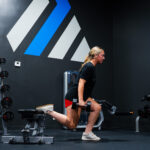Sports Specific Training for Basketball Players
Basketball is a high-intensity sport that requires explosive power, speed, agility, and endurance. To reach elite levels of performance, players need more than just general workouts—they need sports specific training tailored to basketball.
Whether you’re aiming to improve your vertical, boost your court speed, or build core strength, sport-specific drills will make a major difference.
Let’s break down the key principles and exercises that make up an effective sports specific training plan for basketball players.
Why Basketball Demands Sport-Specific Training
Basketball involves unique movement patterns and energy demands:
-
Short, explosive sprints
-
Quick changes of direction
-
High jumps and landings
-
Upper-body coordination
-
Reactive agility under pressure
Training these elements directly will prepare your body for game-day conditions.
Key Benefits of Basketball-Specific Training
1. Better Game Performance
Train like you play. Your body learns to perform under the same conditions you’ll face during real games.
2. Increased Vertical Jump
By targeting hip extension, explosive glutes, and ankle mobility, you’ll jump higher and rebound better.
3. Faster Court Speed
Training starts, stops, and lateral movement leads to quicker cuts and better defensive positioning.
4. Reduced Injury Risk
Strengthening stabilizing muscles and improving landing mechanics lowers the risk of knee, ankle, and hip injuries.
5. Boosted Confidence
Knowing you’ve trained your body for real-game demands builds mental toughness and readiness.
Components of Basketball-Specific Training
Each element of sports specific training for basketball should reinforce what happens in the game.
1. Acceleration and Deceleration
Use cone drills and resisted sprints to simulate fast drives and sudden stops.
2. Change of Direction
Basketball demands quick pivots and lateral cuts. Drills like shuffle-to-sprint and 5-10-5 agility runs improve footwork.
3. Vertical Power
Exercises like squat jumps, depth jumps, and medicine ball slams build the force needed for jumping and dunking.
4. Core and Balance
A strong, stable core supports passing, shooting, and defensive stance. Try plank rows and single-leg balance drills.
5. Conditioning
Basketball uses short bursts of high effort with brief rest. Interval training replicates this anaerobic demand.
Sample Weekly Training Plan
| Day | Focus |
|---|---|
| Monday | Lower body strength + jump mechanics |
| Tuesday | Speed + lateral movement drills |
| Wednesday | Core + active recovery |
| Thursday | Upper body strength + power |
| Friday | Court conditioning + game drills |
| Saturday | Light skills and shooting |
| Sunday | Rest and mobility work |
Always include a dynamic warm-up and mobility-based cooldown.
Best Sports Specific Drills for Basketball
Cone Shuffle to Sprint
Purpose: Build lateral speed and reaction time.
How to do it: Set up 3 cones 3 feet apart. Shuffle side to side, then explode into a sprint when called.
Depth Jumps
Purpose: Train jump power and landing control.
How to do it: Step off a box and immediately jump upward. Land softly. Repeat for 3 sets of 5 reps.
Resistance Band Defensive Slides
Purpose: Improve strength and speed in defensive stance.
How to do it: Wrap a resistance band around your knees. Get low and slide side to side quickly for 30 seconds.
Medicine Ball Slam to Sprint
Purpose: Develop full-body explosiveness.
How to do it: Slam a medicine ball, sprint 10 yards, repeat. Perform 3 rounds of 5.
Single-Leg Box Jump
Purpose: Enhance balance and single-leg power for layups or rebounds.
How to do it: Jump onto a low box using one leg. Land softly. Repeat 3 sets per side.
Essential Equipment
You don’t need a fancy gym—just the right tools:
-
Cones (for agility drills)
-
Resistance bands (for strength and mobility)
-
Plyo box (for jumps)
-
Medicine ball (for rotational and slam power)
-
Weighted vest (for vertical jump training)
Each tool should serve a purpose in replicating game situations.
Recovery Matters
Basketball training is intense. Recovery helps you bounce back stronger.
Key recovery tips:
-
Foam roll post-workout
-
Sleep at least 8 hours
-
Rehydrate and refuel properly
-
Stretch and mobilize hips, calves, and shoulders
Skipping recovery slows progress and increases injury risk.
Where to Get Help
Looking to upgrade your basketball performance? Next Level Athletics offers expert-led programs in sports specific training that combine strength, speed, agility, and mental skills—built for basketball athletes.
For science-based training strategies, explore NSCA’s basketball training guide.
Conclusion: Play Hard. Train Smarter.
If you want to dominate on the basketball court, you must train with intention. Generic workouts won’t cut it. Sports specific training prepares your body and mind for the exact movements and pressures of your sport.
Focus on speed, power, agility, and endurance. Train with purpose. And always aim to level up your game.


Recent Comments